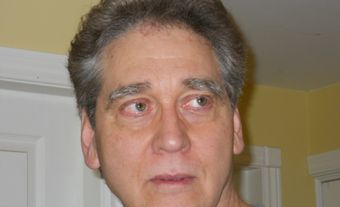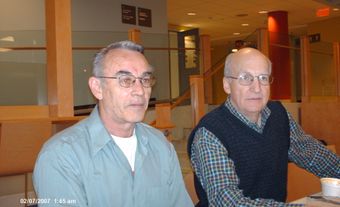
Romeo Phillion was convicted in 1972 for the murder of an Ottawa firefighter. More than three decades later, he became the longest-serving prisoner in Canadian history to have a murder conviction overturned. When authorities refused to retry him for the crime, Phillion was denied the chance to be found innocent at trial, and to potentially receive compensation for his wrongful imprisonment.
Early Years
Born in Cobalt, Ontario, on 29 April 1939, Phillion was the fourth of nine children. At the age of eight, his parents sent him to a training school for orphans and truants run by a Christian order. He was sexually abused and bullied.
Phillion grew into a shiftless drifter. He learned to live by his wits, lying and committing petty crimes to survive, and consorting with other two-bit criminals. He compiled a criminal record that included convictions for living off the avails of prostitution, theft and assault.
Leopold Roy Murder
On 9 August 1967, Ottawa firefighter Leopold Roy was stabbed to death in an apartment building where he was superintendent. With the help of a description supplied by Roy’s wife, Mildred, police assembled a composite sketch of the killer. Days later, Phillion’s sometime-girlfriend Gail Brazeau told police that he resembled the composite sketch.
After seeing him in a police lineup, Mildred Roy also stated that there was a resemblance between Phillion and the man who stabbed her husband. In his defence, Phillion proffered an alibi, saying that he had been several hours away from Ottawa that day, in New Liskeard, ON.
Police realized that the lineup evidence from Mildred Roy was insufficient to sustain a criminal charge. They also found Gail Brazeau to be simple-minded and untrustworthy. They released Phillion.
Confession and Trial
For years, investigators remained stymied. Then, on 11 January 1972, Phillion was picked up for questioning in connection with an armed robbery of a taxi driver. Phillion's 18-year-old boyfriend Neil Miller (Phillion was bisexual), was also brought in for questioning.
Phillion surprised the police by suddenly admitting to the Roy murder and agreeing to supply a full confession if he were permitted to see Neil Miller. Hours later, Phillion recanted his confession, but it was too late.
His trial started before a jury on 16 October 1972. The prosecution case revolved around his confession, Mildred Roy’s testimony, and a claim by Miller that Phillion had privately confessed to him about the murder.
Phillion’s defence lawyer attempted to cast doubt on his client’s mental health. He also painted Phillion as someone who would say anything to make himself sound important — including confess to a murder.
The defence also contended that Phillion and Miller had concocted a plan in which Phillion would confess to the Roy murder in hopes of obtaining reward money. According to the plan, Miller was to corroborate the confession.
On 7 November 1972, the jury found Phillion guilty. He was sentenced to life in prison with no parole eligibility for 10 years. Before being led away, Phillion predicted to his trial judge that the sentence “will kill me.” His subsequent legal appeals failed.
Imprisonment
Phillion was no less erratic behind bars than he had been on the street. In 1990, he walked away from a minimum-security prison in Kingston, ON, and attempted to rob a bank. Handed more than $2,000 by a teller, he caught a cab and returned to his prison, where he handed the money out to other inmates.
Phillion also attempted suicide several times in prison, once lowering a line with fishhooks down his throat and yanking it back up.
When he became eligible for parole, Phillion steadfastly refused to apply because he would not admit to killing Roy. He knew that without conceding guilt, it was highly unlikely that authorities would grant him parole.
McCombie Report
In 1998, a parole officer left a file in Phillion’s cell in Kingston Penitentiary. It included a 1968 report written by Ottawa Police detective John McCombie that ruled out Phillion as a suspect in the Roy murder.
The report detailed how investigators had gone to a service station near Trenton, ON, in 1968 to determine whether Phillion was telling the truth about being on his way back to Ottawa from New Liskeard around the time Roy was murdered. The owner of the Trenton service station confirmed to police that Phillion had been there between noon and 1 p.m. that day. Since Trenton is 237 kilometres away from Ottawa, this made it impossible for Phillion to be the killer.
The police report quoted the service station owner saying that Phillion had left his car radio in lieu of paying for a tank of gas and some simple repairs, “therefore making it impossible for him to return to Ottawa by 2:45 p.m. at the time the murder was committed.”
The report had not been disclosed previously to Phillion or his lawyer.

Proving His Innocence
Phillion began trying to raise interest in his case. In interviews with the media, he was adamant that he would one day prove his innocence. “They want you to sit there and feel remorse for something you didn’t do,” Phillion said in 2001. “I’m going to fight on. I’m innocent and they have no choice. I’ll take any test they throw at me because I’m innocent.”
Phillion conceded that his long-ago confession was a blot that would be difficult to erase. “I was so naive, so stupid,” he said. “I kick my butt for what I did. I ruined my life, for a stupid thing.”
Phillion stated that his primary motivation for making the false statement had been to ensure that Miller didn’t get into trouble.
“Neil was very sensitive; a drag queen,” he said. “Being locked up like that . . . he would die . . . It wasn’t a confession. It was a false statement.”
The Innocence Project and the Association in Defence of the Wrongly Convicted (AIDWYC) adopted Phillion’s case in the early 2000s. In 2003, they submitted a joint application to the federal minister of Justice for a review of Phillion’s case using a Criminal Code provision that permits cases to be reopened when there is pertinent fresh evidence.
The two organizations had also unearthed new evidence showing that Phillion had made startling errors in his original police statements. For example, Phillion had taken investigators to a bridge where he had purportedly thrown his bloodied clothes into a river. However, upon learning that the location was inaccessible by car, he had changed his mind and taken them to a different bridge.
Court of Appeal Hearing
While the minister of Justice considered his application, Phillion was granted bail. In 2006, the minister decided that the fresh evidence raised serious questions about whether Phillion had been wrongly convicted. He ordered that a special hearing be held by the Ontario Court of Appeal to reconsider Phillion’s case.
During the hearing, Detective McCombie testified to a panel of three judges that he had ultimately discovered other evidence that discredited Phillion’s alibi. However, the court majority was skeptical of the claim and concluded that Phillion had not received a fair trial. They ordered a retrial.
Instead, on 29 April 2010, the Crown simply withdrew the charge against Phillion. Prosecutors said it would be futile to attempt to try the case again after so much time had passed. The Crown’s decision left Phillion in legal limbo. Unconvicted — yet not shown to have been the victim of a miscarriage of justice — he was deprived of the possibility of obtaining financial compensation, outside of a civil lawsuit.
Supreme Court Ruling
A quiet and well-mannered man in his later years, Phillion never gave up his search for justice. He launched a lawsuit against police and the Crown in 2013. However, it was dismissed by an Ontario Superior Court judge.
Shortly before his death in late 2015, the Supreme Court of Canada disagreed with the lower court ruling and upheld Phillion’s right to pursue the lawsuit. Nine months later, however, Phillion died of emphysema at the age of 76, leaving his lawsuit in legal limbo.

The Phillion case has come to stand for the unreliability of eyewitness evidence — such as Mildred Roy’s police lineup identification. It is also regarded as proof that, as counterintuitive as the notion may seem, individuals do sometimes falsely confess to serious crimes.

 Share on Facebook
Share on Facebook Share on X
Share on X Share by Email
Share by Email Share on Google Classroom
Share on Google Classroom


